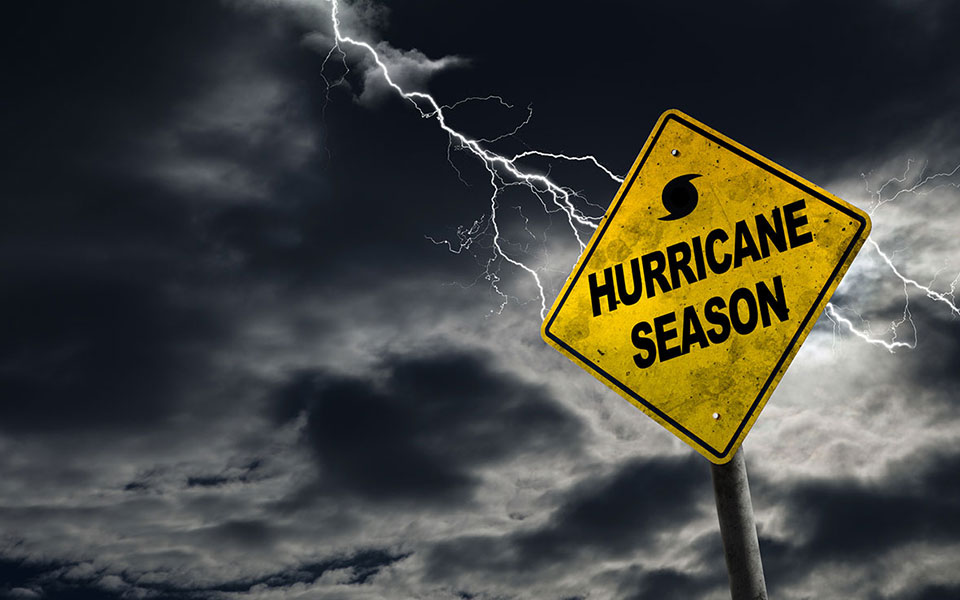Hurricane season’s impact is undeniable as demonstrated by the destruction caused by Hurricane Beryl. Making landfall as a Category 1, the storm shattered hurricane development records across the Caribbean. Insured losses are estimated at $4.5 billion, excluding the extensive flooding and widespread power outages that left millions without electricity during a heat wave. As researchers at Colorado State University recently increased their 2024 forecast, preparedness and resilience are crucial. A comprehensive disaster plan and appropriate insurance coverage are the best defenses to safeguard your operations.
The Importance of Hurricane Readiness for Your Businesses
Hurricane preparedness is crucial for organizations, even those not in the direct path. Thriving in severe weather, companies are challenged to maintain operations while prioritizing employee safety and protecting assets. Consider these areas that can impact your company:
- Supply Chain Challenges: Hurricanes can disrupt transportation networks, ports and suppliers. This can cause delays and shortages for companies reliant on goods from affected.
- Economic Impact: These storms can influence market stability and reduce consumer spending, impacting businesses nationwide.
- Employee Safety: Supporting workers with ties to hurricane-prone regions can enhance morale and boost retention rates.
- Operational Resilience: Even if not in the direct path, unforeseen power outages, communication disruptions and infrastructure challenges can still impact operations. A robust emergency plan ensures business continuity and minimizes downtime.
- Insurance Coverage & Pricing: Hurricane preparedness can influence insurance premiums and coverage, leading to favorable terms and faster recovery.
This Year’s Hurricane Season Predictions
Researchers at Colorado State University have revised their prediction for the Atlantic hurricane season, estimating a minimum of 25 named storms, of which 12 are likely to become hurricanes.
“Hurricane Beryl, a deep tropical Category 5 hurricane, is also a likely harbinger of a hyperactive season,” said the team, led by Philip J. Klotzbach, CSU meteorologist and a nonresident fellow for the Insurance Information Institute (Triple-I).
The CSU team added, “Our confidence this year is higher than normal for a July forecast based on the strength and persistence of the current hurricane-favorable large-scale environmental conditions.”
According to Klotzbach, six out of the 12 hurricanes are expected to reach at least Category 3. This is significantly higher than the long-term average of 14 named storms, seven hurricanes and three category 3 or higher storms.
“Normally, when you get early-season storm activity, it doesn’t really tell you a lot about what’s likely to happen the rest of the year. But when you get that storm activity in the deep tropics, or the Atlantic tropics or eastern Caribbean, as we saw with Beryl, that’s typically a sign of a hyperactive or extremely busy season,” said Klotzbach.
The latest CSU forecast predicts a 57% probability of a major hurricane (Category 3, 4, or 5) hitting the U.S. coast, surpassing the usual 43% average. The East Coast faces a 31% likelihood, with the Gulf Coast at 38% chance of experiencing significant hurricane impacts. “Coastal residents are reminded that it only takes one hurricane making landfall to make it an active season for them. Thorough preparations should be made for every season, regardless of how much activity is predicted,” CSU said.
Assessing the Risks: Hurricane Impacts on Operations & Property
Business Continuity Exposures
Hurricanes present direct and indirect threats to your operations Direct risks include physical property damage, disruptions from power outages or infrastructure damage, and inventory or equipment losses. These storms can cause injuries, leading to liability claims.
Supply chain disruptions, escalated repair and insurance costs, revenue loss from business interruption and reputational damage from perceived negligence or unpreparedness are indirect risks businesses face. Companies in hurricane-prone areas may experience decreased profitability from lower customer traffic or demand. The multifaceted impacts of hurricanes underscore the importance of preparedness and risk mitigation strategies.
The Impact of Storm Surge, High Winds & Flooding in Property Damage
Storm surge, caused by hurricane winds pushing water onshore can cause significant damage to buildings, equipment and infrastructure. Hurricane winds, exceeding 100 miles per hour, can cause structural damage to roof and wall failures, and damage to windows, doors and signs. High winds can also propel debris (e.g., tree branches), causing further structural damage and endangering individuals onsite.
Flooding, caused by storm surges, heavy rainfall or overflowing water bodies, can penetrate buildings, damage interiors and disrupt utilities. These factors lead to significant property damage and financial losses. Businesses can enhance their resilience by adopting storm-resistant building designs, flood mitigation strategies and emergency preparedness plans.
Vulnerability Analysis: Identifying Weaknesses
Conducting a comprehensive vulnerability analysis can identify hurricane vulnerabilities by examining various aspects of its operations, infrastructure and location including:
- Risk Assessment: Evaluating the potential effects on the business, considering geographic location, historical hurricane data and susceptibility to storm surge, high winds and flooding.
- Physical Infrastructure Evaluation: Inspecting the structural integrity of buildings, warehouses and other facilities for weaknesses that may worsen during a hurricane (e.g., roofs, windows, doors).
- Critical Systems & Equipment Review: Identifying essential equipment, machinery and utilities vulnerable to hurricane damage or disruption (e.g., electrical systems, HVAC units, IT infrastructure).
- Supply Chain & Logistics Analysis: Assessing reliance on suppliers, transportation systems and distribution channels vulnerable to hurricanes.
- Business Continuity Planning: Reviewing existing contingency plans, evacuation procedures, communication protocols and data backup strategies to identify gaps and improve preparedness.
- Employee Safety & Training: Weighing the workforce’s readiness for hurricane threats, including emergency procedures, first-aid training and access to personal protective equipment.
Businesses can strengthen their resilience to hurricanes by conducting a thorough vulnerability analysis and identifying and addressing hurricane weaknesses.
Comprehensive Hurricane Preparedness Plan
Conducting a business impact analysis can help identify areas where your organization needs protection when facing a natural disaster. Your insurance risk advisor can assist with providing disaster and recovery planning expertise. A recovery plan should include:
- Clear and concise directions and assign employee responsibilities.
- An emergency response procedure with notification measures and safety precautions.
- A list of important phone numbers for emergency agencies, clients, contractors and suppliers.
- A communications strategy that includes displaying notices, client outreach and media releases.
- A business continuation plan.
- Considerations if a hurricane impacts your employees’ ability to return to work.
- The financial impact of a potential business shutdown.
- Critical business activities and the resources needed to support them.
- Location of alternative facilities, equipment/supplies and qualified contractors.
- Shareable disaster preparation and recovery plans for your suppliers.
- Location of off-premises duplicate record storage.
- Strategy of computer systems and data protection
Choosing the Right Insurance Coverage
Insurance coverage is vital during hurricane season as it protects businesses from significant financial losses due to property damage, business interruption and liability claims. The coverage supports property repairs, income loss, ongoing expenses during disruptions and protection against lawsuits. Tailoring coverage to hurricane risks offers peace of mind and businesses to focus on disaster preparedness measures.
Explore several insurance coverage options to protect against the various risks associated with hurricanes such as:
- Commercial Property: Covers hurricane-related damage to buildings, equipment and inventory.
- Business Interruption: Provides for lost income and expenses from a temporary closure.
- Flood: Protects against damage caused by flooding caused by storm surges and heavy rainfall, not typically covered by standard policies.
- Windstorm: Specifically covers damage caused by high winds associated with hurricanes, which may be excluded from standard property insurance policies.
- General Liability: Shields the business from legal claims and lawsuits related to injuries or property damage caused by the hurricane.
Assessing the Adequacy of Your Current Coverage
III highlighted the importance for property owners to examine their policies carefully. Rising insurance rates have led many policyholders to reduce coverage, increase their deductibles or switch providers.
Recent data shows a 55% increase in replacement costs since 2019 due to rising construction materials and labor expenses. Clients must consult their broker about adequate coverage to address rebuilding, repairing, and replacing at current costs. should also take steps to prepare for natural disasters to mitigate losses to maintain long-term availability and affordability of their insurance coverage, according to the American Property Casualty Insurance Association of America (APCIA).
“An active and costly hurricane season could exacerbate the challenges that many policyholders across the U.S., but particularly in disaster-prone regions like the hurricane coastline, face with rising insurance costs and availability challenges,” said Michael Richmond-Crum, director of personal lines at APCIA.
We’re Here to Help Your Business Stay Ahead of the Storm
Don’t let a lack of insurance coverage or poor planning destroy your business. A qualified risk management advisor can help you understand your policy deductibles and limitations. Connect with a member of our team for insights on disaster planning and finding the right insurance coverage needs.
© Copyright CBIZ, Inc. All rights reserved. Use of the material contained herein without the express written consent of the firms is prohibited by law. This publication is distributed with the understanding that CBIZ is not rendering legal, accounting or other professional advice. The reader is advised to contact a tax professional prior to taking any action based upon this information. CBIZ assumes no liability whatsoever in connection with the use of this information and assumes no obligation to inform the reader of any changes in tax laws or other factors that could affect the information contained herein. Material contained in this publication is informational and promotional in nature and not intended to be specific financial, tax or consulting advice. Readers are advised to seek professional consultation regarding circumstances affecting their organization.
“CBIZ” is the brand name under which CBIZ CPAs P.C. and CBIZ, Inc. and its subsidiaries, including CBIZ Advisors, LLC, provide professional services. CBIZ CPAs P.C. and CBIZ, Inc. (and its subsidiaries) practice as an alternative practice structure in accordance with the AICPA Code of Professional Conduct and applicable law, regulations, and professional standards. CBIZ CPAs P.C. is a licensed independent CPA firm that provides attest services to its clients. CBIZ, Inc. and its subsidiary entities provide tax, advisory, and consulting services to their clients. CBIZ, Inc. and its subsidiary entities are not licensed CPA firms and, therefore, cannot provide attest services.















